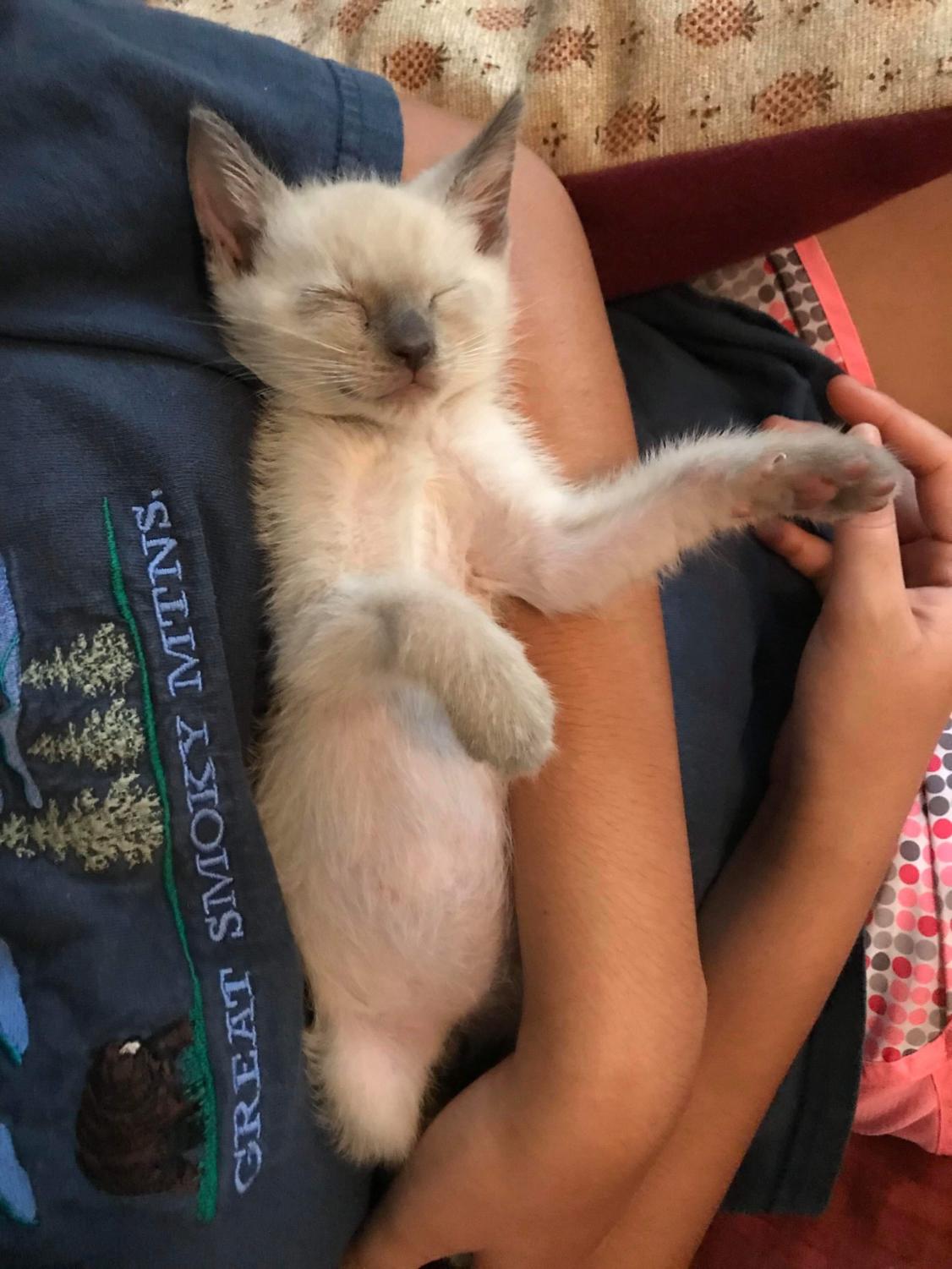Editors’ Note
The year 2020 has, by all human accounts, been among the more difficult ones in recent history. But even though this year’s trials have made our species’s world isolating, fraught, and just plain difficult, an eye toward some of our non-human companions reveals stories of joy, hope, and renewal.
Grad student Hannah Morin’s chicks grew from puffballs into full-fledged chickens; second-year Denise Fischer grew closer to her nocturnal hedgehog as their sleep schedules started to match up; and second-year Carissa Greene’s once-feeble foster kittens are now healthy and up for adoption. Whatever difficulty this year brings, these stories reminded us that our faithful companions will be there to sustain and cheer us during this time of need.
“So Intelligent, and Very Dumb at the Same Time”: Three Pet Chickens
Hannah Morin’s senior spring did not go how she expected it to.
Morin, a resident assistant (R.A.), was kicked off of campus when housing closed due to the pandemic. And, having finished her undergraduate degree, she opted not to take any online classes. So, she found herself at home in rural New Jersey with a lot of time on her hands—until one day.
“One day, I kid you not, I was sitting at my laptop going, ‘Oh dear god, how do I fill all this time?’” Morin narrated to The Maroon. “And then my mom popped her head in, and was like, ‘Hey, want to go get some chickens?’ And I said, ‘Now?’ And she said, ‘Yup!’ And I said, ‘Okay!’”
And so they did. Morin drove with her mother to a local farm store, which had buckets of 30 or 40 peeping chicks for sale. They picked out three—one Australorp chicken, which they named Bok Choi, and two Ameraucana chickens, Chickpea and Zucchini—and drove them home that very day.
Morin kept the chicks in her bathroom at first, but she would occasionally lay a sheet down in her room and let the chicks roam free. This led to some uplifting encounters during an otherwise stressful period, she said.
“I’d been working on my thesis, typing a lot, and suddenly this fluffy pom-pom would appear on my arm,” she said. “At that time, I was waking up and reading the news every morning, and that was very stressful, and I was sad about my senior year being disrupted…. But [it was] very hard to stay grumpy or sad about the world when I was spending time with these fluffy little creatures.”
When they became old enough to go outside, Morin devised a unique transportation system to carry the chickens through her house. She would put on her “poop suit,” an old sweatshirt, squat down to the floor, and the chicks would hop onto her shoulders and head.

“I’d be walking through the yard with a bird on my head, bird on a shoulder, bird on the other shoulder, transporting these tiny chickens,” she said.
Morin has enjoyed watching Bok Choi, Zucchini, and Chickpea blossom from infancy to adulthood, noting certain signs of maturity.
“It was very cool to watch them discover the world and change,” she said. “As they got older, they became active for longer periods of time, they started preening their feathers, they started growing combs, and their sounds changed.”
As the chickens have grown up, she has been struck by their budding curiosity and sense of awe about the surrounding world.
“They’re incredibly curious: If I’m wearing different-colored pants, and they’ve never seen my pants before, they’ll come up and peck my pants, trying to figure out what’s going on,” Morin said. “There’s a certain sense of awe they have when interacting with the world.”
Morin’s family had raised chickens twice before for a family friend in sets of 10. With fewer birds under her watch this time around, Morin has been able to observe the chickens’ development more closely. She has been surprised by their simultaneous intelligence and stupidity; the chickens have learned basic self-care skills such as preening, she explained, but they struggle with the concept of doors.
Still, Morin has been struck by the birds’ individuality, and has emerged with a newfound respect for the chickens’ complex selves.
“I was surprised by their depth. They have a soul,” she said. “It’s just been great to observe what a chicken actually is and see their personality and their growth, and [also to] see how many dimensions they have as an organism.”
Fostering Felines: From Kitten to Cat
Second-year Carissa Greene and her family recently started fostering three kittens named Ritz, Nabisco and Tollhouse , still young enough that their sexes are indeterminate.
She and her sister had wanted pets for their entire lives, she said, but aside from three betta fish that died when Greene was in elementary school, they hadn’t gotten their wish until recently.
Around a month ago, her family took in a tiny kitten that her father discovered near the elementary school where he works, but wound up giving it away shortly after. The experience only intensified Greene’s longing for feline companionship.
Greene’s best friend, who had recently adopted two kittens from a local shelter, told her to consider fostering.
“I just begged my mom so much,” Greene said, “just constantly annoying her every two to three hours while I was awake, on the dot.”
Her mother eventually relented, and the family wound up bringing home a trio the shelter dubbed “the cracker gang,” naming all three after snack brands.

The kittens had eye infections and fleas when they first arrived, so Greene’s family immediately set about administering ointment and combing through their fur.
Greene’s father, initially resistant to the idea of foster cats, quickly warmed up to the newcomers, buying them an array of toys and trying to teach them to use the stairs.
As the tiny kittens have grown up, they have become increasingly rambunctious.
“I actually have to watch them more, because they’ve learned how to climb things,” Greene said. “My living room where we keep them has been baby-proofed beyond belief.”
After having to extract the kittens from under furniture and inside their fireplace, Greene’s family has resorted to building cardboard barricades to keep them safe from themselves.
The kittens’ individual personalities started to emerge in the weeks after their arrival. Of the three, Tollhouse has become the most attached to his human hosts.
“His favorite thing to do is if you’re laying [down], he’ll come and tuck himself under your neck and your chin, so that he’s covered in warmth,” Greene said. “It’s very cute.”
Ritz enjoys being pet, to the point that they will scream until someone obliges them, while Nabisco has demonstrated a particular interest in Criminal Minds.

The kittens have even warmed up, ever so slightly, to the idea of their second washcloth bath.
“It wasn’t a huge progression, but they were noticeably screaming less,” Greene said.
Greene has had a rewarding experience fostering cats, and recommends that other students who have the opportunity do the same.
“Animals are worth it,” she said.
Bearded Dragon: A Quiet, Laid-Back Companion
When third-year Livia Miller got her paycheck in summer of 2017, she knew exactly how to spend it.
Miller was working at a nature sanctuary the summer before her senior year of high school. Part of her job was to take care of a bearded dragon: a lizard named for the smattering of spikes under its chin. She immediately took a liking to the “chill,” raspberry-loving creature, and resolved to get her own.
That summer, Miller bought a bearded dragon off of Craigslist—a platform she recommends for prospective reptile owners due to the amount of rescue pets being sold. She took the 5 Train from her hometown of Manhattan up to the Bronx, where she was handed “a teeny tiny lizard” in a takeout container. She rode the subway back home, lizard in tow.

Miller, an enthusiast of classical studies, named the bearded dragon after the Roman poet Virgil. She describes Virgil as playful and mischievous, and she has a frank admiration for his “funky personality.”
“When I first got him, I would leave the top of his tank open, and he would find ways of crawling out. He’s just very inventive and curious,” she said. “He’s a funny little dude.”
When she does take Virgil out, he enjoys sitting on her shoulder or looking out the window to soak in sunlight. But for the most part, Miller said, reptiles tend to be “super chill,” not requiring too much physical attention.
“You get as much out as you put in, because they’re really happy just sitting under the lamps or basking in the light,” she said. “Unlike a cat or a dog, they don’t need a lot of engagement.”
Virgil’s favorite foods are hornworms, live crickets, and cilantro, which he eagerly “monches” directly out of Miller’s hand.
Preparing the lizard’s food is a big component of Miller’s pet responsibilities; live insects are a vital part of bearded dragons’ diets, and Miller purchases them in bulk.
“I buy them from a breeder online, and he sends me these crazy packages that say, ‘CAUTION: LIVE CONTENTS,’ which freak out my neighbors, I think,” Miller said. “Every day, I shake a few insects into his enclosure…. They’re kind of like a secondary pet in and of themselves, since I have to provide feed and substrate for the insects too.”
Miller has been able to spend more time with Virgil during quarantine, even making a small hammock out of an old t-shirt and industrial suction cups to put inside his terrarium. At the end of the day, Miller said, Virgil’s quiet, steadfast companionship has carved out a special place in her heart.
“On a day-to-day basis, he’s not demanding, but it’s kind of nice just to know that he’s there,” she said. “I’m in my room, and he’s on his rock, and we just hang out together.”
Pip the Hedgehog: A Nocturnal Companion
Home from college during quarantine, second-year Denise Fischer had, like many students, started going to sleep increasingly late. While being nocturnal in a diurnal society can be isolating for some, Fischer’s sleep schedule brought her closer to a spiny companion: her pet hedgehog, Pip.

The family had purchased Pip several years before the pandemic hit, at the request of Fischer’s little sister. But Fischer hadn’t gotten to know Pip very well, as she was usually asleep for his period of prime activity. Now, she said, things have changed.
“I absolutely destroyed my sleep schedule during quarantine and became nocturnal, and hedgehogs are nocturnal,” she said. “[Pip] would usually come out of [whichever] of the hiding places he was in, and be more receptive to coming out of his spikes—he would uncurl.”
As their sleep schedules aligned, the pair started spending more time together, and Fischer spent more time observing Pip’s daily habits. Hedgehogs are known to run several miles a night on their wheel, and Fischer grew fond of the sound, likening it to the sound of rainfall.
“We got to hang out more, and I got to listen to the ambience of his wheel turning in the middle of the night,” she said. “It’s nice white noise.”
In his free time, Pip also enjoys scavenging in his “dig box” and hiding in various parts of his cage.
After just a short period of bonding, the signs of their friendship are already visible—and palpable. Fischer initially had to wear a glove to protect her hand from Pip’s spines, but she is now able to hold Pip with a bare hand, having mastered the technique of evenly distributing his weight across her hand.

This has spoken to a broader lesson of pet parenthood which Fischer also learned when raising a bearded dragon: that with care, an initially tough exterior can give rise to soft companionship.
“At first, you’re like, ‘They’re spiky; you can't hold that, you can’t touch that.’ But now, I realize that if you handle them a certain way, then you can absolutely pet them,” she said. “Hedgehogs have a soft underbelly that’s very fuzzy, and so when they uncurl, then you get to see that. So, they do have a very nice, spiky defense mechanism, but they’re also quite cuddly.”
Tiny Red Shrimp: Pets, Roommates, Muses
Responsibility is perhaps the hallmark of pet ownership: Dogs must be walked, fish must be fed, cats’ litterboxes must be cleaned. But second-year Noelle Norona has subverted the traditional pet-owner dynamic with a pet that neither relies on nor is aware of her existence: tiny red shrimp.
Norona, an only child, has raised an astonishing range of pets: lizards, dogs, fish, insects, and more. When she was sent home from campus in spring quarter due to the pandemic, she sought out a low-maintenance critter to keep her company at home. Stumbling upon the shrimp when browsing Amazon one day, she realized they were the perfect fit.
The shrimp are sold as part of an aquatic ecosystem which sustains itself through an elaborate cycle of symbiosis. The algae perform photosynthesis, which releases oxygen for the shrimp to breathe; the shrimp feed on the algae and release waste into the water; finally, microorganisms break down the shrimp’s waste, which provides nutrients for the algae.
In other words, Norona doesn’t need to feed the shrimp or change their water: She just observes them.
“We’re like roommates that don’t interact with each other in any way,” she said. “We have an observational relationship: They just watch me at my desk, and I watch them.”

Her mother named Enzo, the smallest shrimp, and Norona named the three larger shrimp after historical figures. Walter, the second-smallest, was named after Walt Whitman; Victor, the third-smallest, after Victor Hugo; and Diogenes, the largest shrimp, after the famed Greek philosopher by that name.
When asked what the shrimp do, Norona’s answer was simple: “They swim around.”
“They eat their algae. They sit on their little shell. They don’t really interact with one another in a way that’s particularly noticeable,” she said. “I don’t know, maybe they’re communicating in their shrimp way, but they just kind of hang out.”
Despite the social barrier between Norona and her shrimp, she still finds their presence uplifting and comforting.
“If I’m sitting at my desk doing work, I’m like, ‘Hi guys,’ and they’re swimming around; it’s definitely a level of friendship there,” she said. “It’s a nice serotonin boost when you’re in the middle of doing things, especially during quarantine.”
The shrimp’s simplicity—and apparent obliviousness of their habitat’s surroundings—has moved Norona, a philosophy major, to introspection.
“It’s kind of weird; they don’t know that they're being watched. They’re just in my home, and they have no idea…. I don’t even know if they know that I exist as a person,” she said. “Imagine being a shrimp. What would I think about?”
Norona even ventured that her relationship to her shrimp may be more authentic than that with her dogs, due to the former’s lack of a dependency complex.
“My dogs are A1 manipulators; they’ll be all cute, and then I feed them, and then they leave,” she said. But with shrimp, “it definitely does feel like an equal relationship. They watch me like I watch them; they don’t provide me with anything I need to survive, and I don’t provide them with anything they need to survive, except for sunlight. Which is cool.”
Norona enjoys tiny pets, and the shrimp are not her first; during quarantine alone, she has raised several ladybugs from larval stages until adulthood, as well as two prickly stick insects. This has allowed her to watch life develop on a scale that, in nature, can be difficult to spot.
“You never really get the opportunity, in nature, to look at insects, marine life, tiny reptiles or amphibians. Either they’re skittish and they run away, or they’re really small, or you don’t find them where you live,” she said. “Having smaller pets, you get to learn about them, and you get to observe them. They’re little tiny guys.”
Norona generally rejects human attempts to anthropomorphize animals, dismissing them as projections of the human ego into unsuspecting creatures. But when she does indulge in the practice, she finds delight in the shrimp’s small echoes of personhood—perhaps even a shred of friendship.
“We try to attach humanity to as many things as we can…. We need to find kinship in everything that we interact with, which is maybe sad, but maybe also beautiful,” she said. “You can find friends anywhere as a result, like in tiny shrimp.”



















